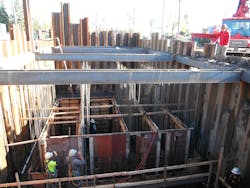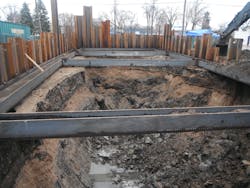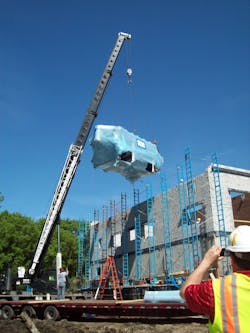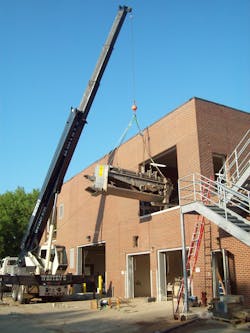Plant Profile: McHenry’s South Wastewater Treatment Plant
In 2005, the aging Central Wastewater Treatment Plant (CWWTP) in the city of McHenry, Illinois, had violated its permit for total suspended solids (TSS) and ammoniacal nitrogen.
Steps were taken immediately by the city to get the plant back in compliance.
The City of McHenry reached an agreement with the Illinois Environmental Protection Agency (IEPA) that the city would replace the CWWTP by 2018 and the IEPA would not take further action against the city. It was agreed that all wastewater treatment would be consolidated at the South Wastewater Treatment Plant (SWWTP)
McHenry provides wastewater treatment for 27,250 people in the residential, industrial and commercial sectors.
“We were going to do this plan over a period of 10 years, ending in 2018 when we would decommission the old treatment plant in town,” said Russell Ruzicka, treatment operations manager. “We began planning and taking steps getting funding together for the first phase of what we called a consolidation/expansion project because we were consolidating all of our treatment on the south side, but yet we were also expanding our capacity on the south side to handle that.”
Connecting Three Force Mains
A headworks screen unit was installed at the CWWTP to replace the failing primary clarifiers. All sludge processing and dewatering, and solids handling were consolidated at the SWWTP. This phase cost $7.5 million, Ruzicka said.
In order to complete the project, the city needed to secure a State Revolving Fund (SRF) loan from the state. To qualify for the loan, a rate study commenced, examining all costs and expenses. Upon its completion in 2015, the sewer rates were raised to meet the project’s needs.
Pump Station Interception
The second phase of the project broke ground in December 2015. The second phase consisted of establishing a regional pump station to intercept flow at the CWWTP and pump it to the SWWTP for treatment.
“It is a continuous feed SBR,” Ruzicka said. “The project also saw Hydro International microscreens installed at the headworks.”
The two headworks screens have a 500-micron belt to screen out debris, Ruzicka noted, adding that the units are no longer marketed to the municipal wastewater industry. A Komline Sanderson paddle dryer was added to dry the solids to Class A Biosolids standards. This Class A dried solid has several options for disposal.
“McHenry is one of the first, if not the first, small municipality of a population of under 50,000 in Illinois to own and operate their own sludge dryer,” Ruzicka said. “This piece of equipment saves the city approximately $200,000 per year in disposal costs and produces a product with several disposal options.”
Also as part of the project, a BioActiflo high-rate clarifier was constructed to treat excess stormwater flow.
“The IEPA requested additional data from the manufacturer before they would permit this process because it had not been used in this manner to treat wet weather flows in Illinois before,” Ruzicka said.
Handling Storm Events
“We have biological nutrient removal (BNR) associated with those oxidation ditches and the clarifiers have very limited BNR,” Ruzicka said. “We do add ferric chloride to help precipitate phosphorus removal in the SBRs and the oxidation ditch.”
Effluent from the two different treatment processes is combined and goes through Veolia Disc filters (formerly Kruger) and then ultraviolet (UV) disinfection and post-aeration before it is discharged into the Fox River located approximately 60 miles northwest of Chicago.
The plant’s daily average flow is 4 million gallons per day (mgd) and the daily maximum flow is 16 mgd. The UV disinfection is 24 mgd.
“When an SBR basin decants during a storm, we can see 21 MGD peak instantaneous flow,” Ruzicka said.
Follow the Flow
The system’s new 6-inch force main from the SWWTP carries non-potable water to the regional pumping station for headworks screen backwash cleaning.
The 16-inch force main carries normal daily flow of raw sewage from the regional pumping station to the SWWTP for treatment. The 24-inch force main carries stormwater flow from the regional pumping station to the SWWTP for treatment.
The SWWTP has a 30-inch gravity sewer feed and a 14-inch force main from the south side of the city.
“The city of McHenry has a little more than 50% inflow and infiltration,” Ruzicka said. “When we have a rain event, we see a substantial increase in our flow to wastewater plants, especially on the north side of town which is older. The city is mandated by its permit to treat this stormwater flow so, as part of the regional pump station design, two large stormwater 300-horsepower pumps were installed there to handle the stormwater.”
Ruzicka advised other municipalities that getting buy-in from a city’s elected officials, residents and business owners is crucial for projects such as McHenry’s.
The pain point had been that the city had been putting a ‘bandage’ on the challenging situation for a long time, Ruzicka said.
He said the permit violations and the fact that nearly $10 million would have to be spent to bring the aging facility up to code was a driving factor in all parties agreeing change was necessary.
“We ended up spending $30 million. Now we are set for the foreseeable future as far as our wastewater treatment needs,” Ruzicka said.
Location: McHenry, Illinois
Size: 4 mgd daily average; 16 mgd peak
Equipment: clarification, dewatering, extended aeration, sequencing batch reactor, headworks, paddle dryers, gravity belt thickeners, belt filter presses
About the Author
Carol Brzozowski
Carol Brzozowski is a freelance writer for Wastewater Digest. Brzozowski can be reached at [email protected].




